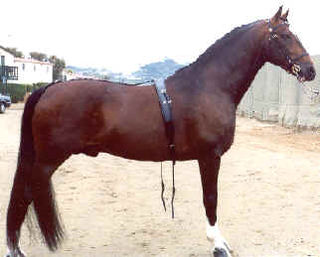
The Hackney is a recognized breed of horse that was developed in Great Britain. In recent decades, the breeding of the Hackney has been directed toward producing horses that are ideal for carriage driving. They are an elegant high stepping breed of carriage horse that is popular for showing in harness events. Hackneys possess good stamina, and are capable of trotting at high speed for extended periods of time.

The Cleveland Bay is a breed of horse that originated in England during the 17th century, named after its colouring and the Cleveland district of Yorkshire. It is a well-muscled horse, with legs that are strong but short in relation to the body. The horses are always bay in colour, although a few light hairs in the mane and tail are characteristic of some breed lines. It is the oldest established horse breed in England. The ancestors of the breed were developed during the Middle Ages for use as pack horses, when they gained their nickname of "Chapman Horses". These pack horses were cross-bred with Andalusian and Barb blood, and later with Arabians and Thoroughbreds, to create the Cleveland Bay of today. Over the years, the breed became lighter in frame as they were employed more as carriage and riding horses. The popularity of the Cleveland Bay has greatly fluctuated since it was first imported to the United States in the early nineteenth century. Despite serious declines in the population after the Second World War, the breed has experienced a resurgence in popularity since the 1970s, although only around 550 horses existed worldwide as of 2006.

The Russian Don is a breed of horse developed in and named after the steppes region of Russia where the Don River flows. Utilized originally as cavalry horses for the Cossacks, they are currently used for under-saddle work and driving.
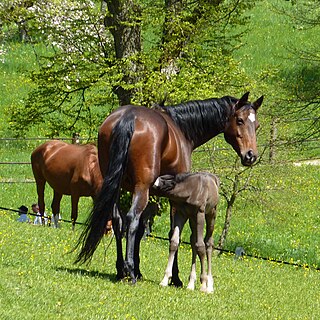
The Württemberger, Baden-Württemberger or Württemberg is a Warmblood horse breed originating in Germany. They are primarily riding horses, and are selectively bred for dressage and show jumping.
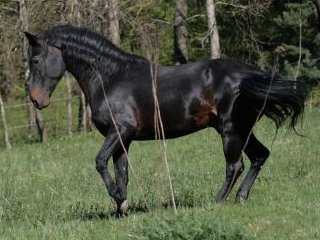
The Kabarda, Kabardin or Circassian horse is a breed from the Caucasus, originating from Eastern Circassia, currently part of the Kabardino-Balkaria region of Russia. Historically the breed has been known for at least 400 years, but its origins are probably as old as the Hittite civilization. These horses are noted for their endurance and ease to adapt in difficult environments.

The Budyonny is a breed of horse from Russia. It was bred as a military horse after the Russian Revolution of 1917; in the twenty-first century it is used as an all-purpose competition horse and for driving.
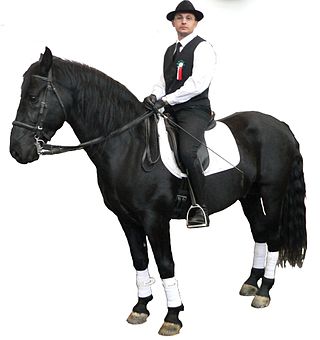
The Murgese horse originated in the Murge, Apulia area of Italy during the Spanish rule, and was developed from Barb and Arabian horses. They are a hardy breed that is used mainly for cross-country riding, although they have also been used for light draft work.

The Bali pony is an ancient breed now living on the Indonesian island of Bali.

The Sumbawa Pony is a pony breed, named after the island on which they are bred, Sumbawa Island in Indonesia. This breed is very similar to the Sumba or Sandalwood Pony, a breed also developed in these islands, which came from crossing the native ponies on horses of Arabian breeding. The Sumbawa Pony descends from Mongolian Horses and ancient Chinese stock
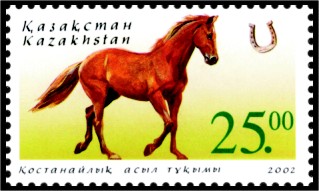
The Kustanair is a breed of horse developed in Kazakhstan in the former U.S.S.R. in the late 19th and early 20th centuries. They are used mainly for under-saddle and light draft work.
The Lokai, a mountain horse bred in Tajikistan, is used as a riding horse, a packhorse, or even sometimes a light draft horse. Although small, the breed is agile and hardy. The breed was developed by crossing native mountain horses with a mixture of Central Asian and European bloodlines.
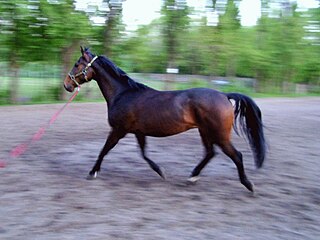
The Malopolski is a Polish horse breed developed in the 19th century in Lesser Poland, Polish Małopolska, hence the name. It is versatile breed, used today for light draft and under-saddle work. It was developed mainly from native Polish horses crossed with Thoroughbreds and Arabians, and a 2006 study shows a strong genetic presence of Thoroughbred bloodlines within the breed today. Population numbers have been in decline since the late 20th century, but genetic studies show little danger of inbreeding at this time.

The Jutland horse is a draft horse breed originating in Denmark, named after the Jutland Peninsula which forms the western part of the country. Usually chestnut, they are a compact, muscular breed known for their calm and willing temperament. The breed was originally developed for use in agriculture, but today is more often seen in urban settings and at horse shows. Some of the best known members of the breed pull beer wagons for the Carlsberg brewery around Copenhagen, as well as at competitions and for demonstrations. Images from the 9th century show a horse similar to the Jutland being used by Viking raiders in what is now Great Britain. The first written record is from the 12th century, when they were popular as war horses. Some infusion of bloodlines from other breeds occurred in the 18th century, but the modern Jutland type only began about 1850 with the addition of blood from several other breeds, mainly draft horses. A stud book was created in the late 19th century, and the Jutland population grew to a maximum around 15,000 by 1950. Numbers subsequently declined, and as of 2011, only an estimated 1,000 horses remained.

The French Saddle Pony, also called the Poney Français de Selle, is a pony breed developed as a sport pony for children and smaller adult riders. It was initially developed in 1969 as the Poney de Croisement, and in 1972 a stud book was created. In 1991 the stud book was closed and the breed renamed to Poney Français de Selle. The breed combines a mix of French and British pony breeds, as well as Thoroughbred and Arabian blood, to create the horse seen today. Due to the large number of breeds used to create the French Saddle Pony, there is not yet a defined set of physical characteristics for the breed, although all tend to be suited for competition in English riding disciplines, including dressage, show jumping and three-day eventing. They fill a similar role as the British Riding Pony and the German riding pony.

The Altai is a horse breed developed in the Altai Mountains of Central Asia. It is considered one of the oldest horse breeds in Siberia and has a rich history tied to the nomadic cultures of the region.
The Calabrese is a breed of horse originating from Italy, generally used for riding. They were developed from horses bred in Italy before the founding of Rome, and the breed has continued to be developed to the present day through infusions of Arabian, Andalusian and Thoroughbred blood.
The Karacabey horse is a now-extinct horse breed. It was a light riding horse that originated in Turkey.

A pony is a type of small horse. Depending on the context, a pony may be a horse that is under a given height at the withers, or a small horse with a specific conformation and temperament. Compared to a larger horse, a pony may have a thicker coat, mane and tail, with proportionally shorter legs, a wider barrel, heavier bone, a thicker neck and a shorter, broader head. The word pony derives from the old French poulenet, meaning foal, a young, immature horse.
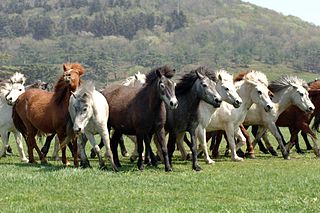
The Jeju horse is a horse breed native to the Jeju Island in South Korea. There is a diverse array of types, each differently identified depending on their coat color. Jeju horses mature well in harsh conditions due to their strength and fitness. With an outstanding tolerance of low temperatures, they have been mostly pastured without the need for horse blankets or stables.
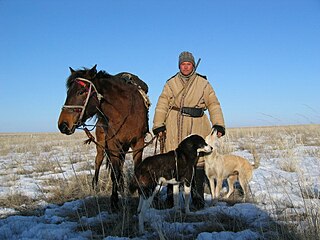
The Adaev is a breed of saddle and light draft horse native to the desert regions of southern Kazakhstan. It is one of the two types of the Kazakh breed, along with the Jabe. Finer and less hardy than the Jabe, the Adaev is an "Oriental Turk" type. It is mainly used for local equestrian sports and herding. Mares are milked for their milk. Like most Kazakh horses, the Adaev is sometimes slaughtered for its meat, although this is only a secondary purpose. Little known outside its breeding cradle, the Adaev has spread to neighboring Turkmenistan and Uzbekistan, with nearly 29,000 individuals counted in 1990.

















